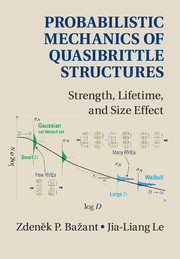Book contents
- Frontmatter
- Dedication
- Contents
- Foreword
- Preface
- 1 Introduction
- 2 Review of Classical Statistical Theory of Structural Strength and Structural Safety, and of Statistics Fundamentals
- 3 Review of Fracture Mechanics and Deterministic Size Effect in Quasibrittle Structures
- 4 Failure Statistics of Nanoscale Structures
- 5 Nano–Macroscale Bridging of Probability Distributions of Static and Fatigue Strengths
- 6 Multiscale Modeling of Fracture Kinetics and Size Effect under Static and Cyclic Fatigue
- 7 Size Effect on Probability Distributions of Strength and Lifetime of Quasibrittle Structures
- 8 Computation of Probability Distributions of Structural Strength and Lifetime
- 9 Indirect Determination of Strength Statistics of Quasibrittle Structures
- 10 Statistical Distribution and Size Effect on Residual Strength after Sustained Load
- 11 Size Effect on Reliability Indices and Safety Factors
- 12 Crack Length Effect on Scaling of Structural Strength and Type 1 to 2 Transition
- 13 Effect of Stress Singularities on Scaling of Structural Strength
- 14 Lifetime of High-k Gate Dielectrics and Analogy with Failure Statistics of Quasibrittle Structures
- Appendix A Power-Law Scaling of Boundary Value Problems
- Appendix B Proof of Transitional Size Effects of Types 1 and 2 by Dimensional Analysis and Asymptotic Matching up to Second Order
- Appendix C Proof of Small-Size Asymptotics of Cohesive Crack Model up to Second Order
- References
- Author Index
- Subject Index
1 - Introduction
Published online by Cambridge University Press: 14 June 2017
- Frontmatter
- Dedication
- Contents
- Foreword
- Preface
- 1 Introduction
- 2 Review of Classical Statistical Theory of Structural Strength and Structural Safety, and of Statistics Fundamentals
- 3 Review of Fracture Mechanics and Deterministic Size Effect in Quasibrittle Structures
- 4 Failure Statistics of Nanoscale Structures
- 5 Nano–Macroscale Bridging of Probability Distributions of Static and Fatigue Strengths
- 6 Multiscale Modeling of Fracture Kinetics and Size Effect under Static and Cyclic Fatigue
- 7 Size Effect on Probability Distributions of Strength and Lifetime of Quasibrittle Structures
- 8 Computation of Probability Distributions of Structural Strength and Lifetime
- 9 Indirect Determination of Strength Statistics of Quasibrittle Structures
- 10 Statistical Distribution and Size Effect on Residual Strength after Sustained Load
- 11 Size Effect on Reliability Indices and Safety Factors
- 12 Crack Length Effect on Scaling of Structural Strength and Type 1 to 2 Transition
- 13 Effect of Stress Singularities on Scaling of Structural Strength
- 14 Lifetime of High-k Gate Dielectrics and Analogy with Failure Statistics of Quasibrittle Structures
- Appendix A Power-Law Scaling of Boundary Value Problems
- Appendix B Proof of Transitional Size Effects of Types 1 and 2 by Dimensional Analysis and Asymptotic Matching up to Second Order
- Appendix C Proof of Small-Size Asymptotics of Cohesive Crack Model up to Second Order
- References
- Author Index
- Subject Index
Summary
Without realistic failure mechanics, probabilistic analysis of structural safety is a fiction.
The Problem of Tail of Probability Distribution
Like most things in life, we must accept that the occurrence probability of any future event cannot be exactly zero. We must be contented with a structural failure probability that is negligible compared to other risks that people willingly take, such as car accidents. It is generally agreed that adequate safety of engineering structures is achieved by specifying a failure probability of 10−6 per lifetime as the maximum admissible in design [Nordic Committee for Building Structures (NKB) 1978; Melchers 1987; Duckett 2005; Ellingwood 2006]. This probability limit is generally accepted for engineering structures, whether bridges or aircraft (Duckett 2005; Department of National Defense of Canada 2007), although for some nuclear plant structures an even smaller limit is required.
The smallness of this probability limit is a source of great difficulty. To check the design merely by an experimental histogram, at least 108 tests of identical structures or specimens would be required. Even a direct computational verification would necessitate about 108 repetitions of Monte Carlo simulations with a fully realistic material model. Therefore, estimations of loads of such a small failure probability must rely on a model that is justified by a sound theory and is validated by experiments other than histogram testing.
For many years, realistic theoretical models have been available for the probability of ductile and brittle failures. The Gaussian and Weibull distributions, respectively, fit this purpose. Failures of structures made of quasibrittle materials are more difficult to predict and have been researched only recently. The difficulty is that the quasibrittle failures are transitional in nature between ductile and plastic failures.
Quasibrittle materials are heterogeneous materials with brittle constituents. At the scale of normal laboratory testing, they include concretes as the archetypical case, fiberpolymer composites, fiber-reinforced concretes, toughened ceramics, many rocks, coal, sea ice, wood, consolidated snow, particle board, rigid foams, particulate nanocomposites, biological shells, mortar, masonry, fiber-reinforced concrete, asphalt concrete (at low temperatures), stiff clays, silts, cemented sands, grouted soils, particle board, various refractories, bone, cartilage, dentine, dental ceramics, paper, carton, and cast iron.
- Type
- Chapter
- Information
- Probabilistic Mechanics of Quasibrittle StructuresStrength, Lifetime, and Size Effect, pp. 1 - 21Publisher: Cambridge University PressPrint publication year: 2017
- 1
- Cited by



